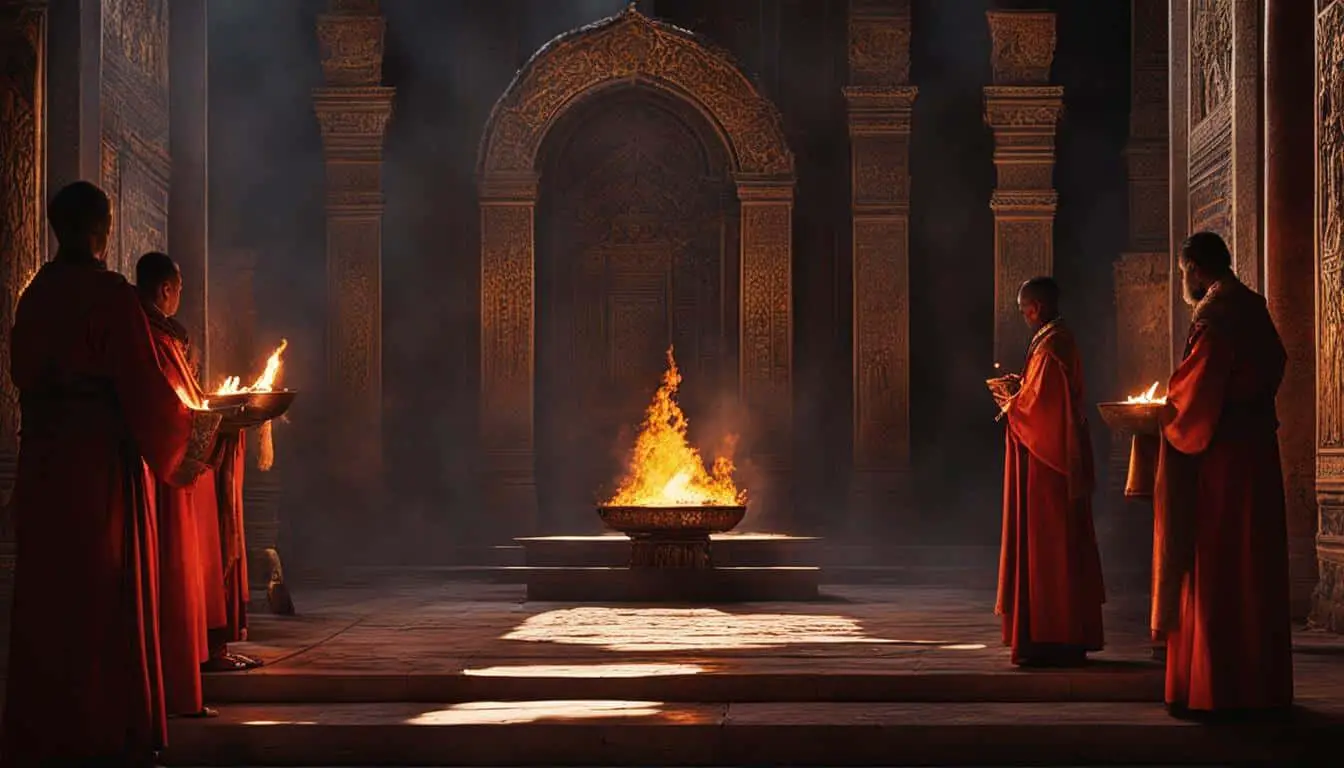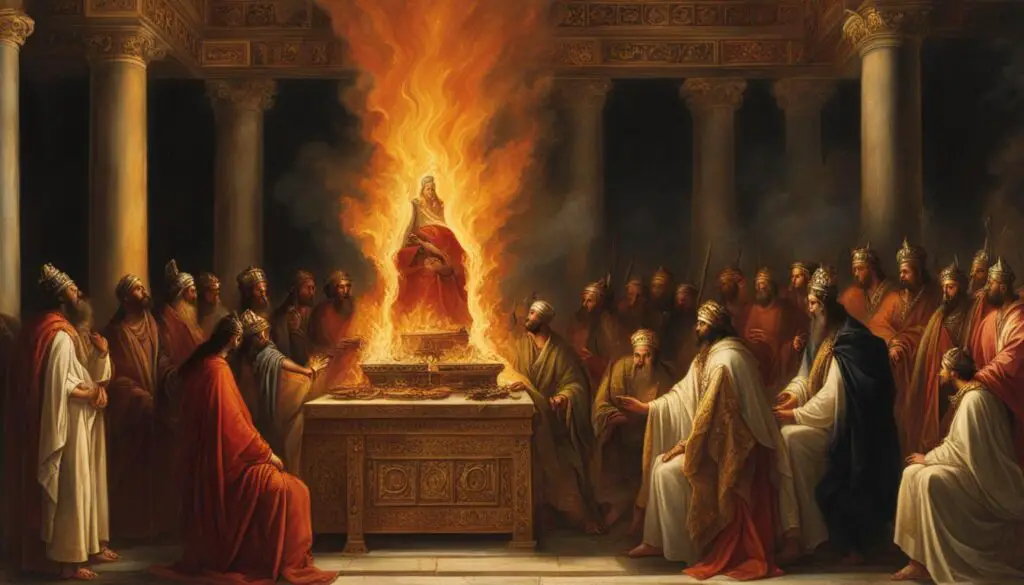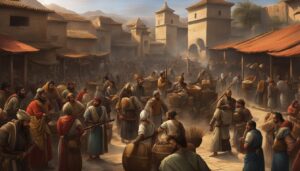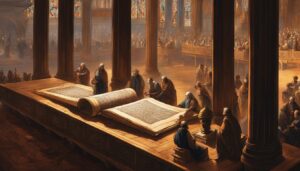
The rituals and ceremonies in the Old Testament hold a significant place in the history and culture of the Hebrew people. These ancient rituals, rooted in the biblical customs and practiced by the Jews, were a fundamental part of their religious life. They served as a means of worship, repentance, and fostering a closer relationship with God.
From sacrifices to purification rites and festivals, these rituals were designed to guide the Hebrews in living a righteous and holy life in accordance with the principles outlined in the Ten Commandments. They played a vital role in maintaining the covenant relationship between God and His chosen people, providing a framework for their spiritual growth and obedience.
Not only were these rituals essential for the Jewish people, but they also carried deeper symbolism and foreshadowed important events and themes in the life of Jesus Christ. As the fulfillment of these rituals, Jesus brought a new understanding and depth to their meaning, transcending the external practices and emphasizing the importance of internal righteousness and genuine repentance.
Key Takeaways:
- Old Testament rituals were integral to Hebrew culture and religious practices.
- They served as a means of worship, repentance, and building a closer relationship with God.
- These rituals were based on the principles outlined in the Ten Commandments.
- They often foreshadowed important events and themes in the life of Jesus Christ.
- Jesus’ ultimate sacrifice fulfilled the requirements of the ritual laws, making many of the Old Testament rituals obsolete.
Significance of Rituals in the Old Testament
The rituals and ceremonies in the Old Testament held immense significance for the Hebrew people. They represented a means of expressing their devotion to God and seeking forgiveness for sins. Through these rituals, the Israelites acknowledged their need for redemption and the importance of upholding God’s laws. The rituals also served as a way to remember and commemorate important events in their history, such as the Passover and the Day of Atonement. These ceremonies were deeply ingrained in the culture and identity of the Jewish people and played a central role in their religious practices.
Religious rituals and Ancient Hebrew ceremonies were not merely empty gestures, but rather intentional acts of worship and connection with the divine. They provided a framework for the Israelites to engage with God on a spiritual level and reinforce their commitment to the covenant relationship. These rituals were not seen as mere obligations but as opportunities for transformation and renewal. By participating in these ceremonies, the Hebrew people sought to align their lives with God’s will and experience His presence in a tangible way.
Furthermore, the rituals in the Old Testament served as a teaching tool, conveying important theological concepts and moral values to the Israelites. They served as visual representations of spiritual truths, using symbolism and actions to communicate deeper meanings. For example, the act of sacrifice symbolized the need for atonement and the cost of sin. The practice of purification rituals emphasized the importance of holiness and purity before God. Through these rituals, the Hebrew people learned about God’s character, His expectations for His people, and the means by which they could approach Him.

The Role of Rituals in Building Community
In addition to their spiritual significance, rituals in the Old Testament also played a crucial role in building a sense of community among the Jewish people. These ceremonies brought the Israelites together in acts of collective worship, reminding them of their shared history and identity. The festivals and pilgrimage rituals provided opportunities for fellowship, celebration, and unity. By participating in these rituals as a community, the Hebrew people reaffirmed their commitment to God and to one another, strengthening the bonds of their covenant relationship.
The rituals in the Old Testament were not mere relics of the past but continue to have relevance and influence in modern religious practices. They offer valuable insights into the nature of worship, the importance of symbols and traditions, and the role of community in spiritual life. While many of these specific rituals are no longer practiced in the same way today, their underlying principles and teachings continue to shape the beliefs and values of those who follow the Abrahamic faiths.
| Ritual | Symbolism | Purpose |
|---|---|---|
| Sacrificial offerings | Symbolized atonement and the need for forgiveness | To seek forgiveness and restore relationship with God |
| Anointing with oil | Symbolized consecration and setting apart for a specific purpose | To symbolically dedicate individuals or objects to God |
| Purification rituals | Symbolized the importance of holiness and purity before God | To cleanse oneself from impurities and sins |
| Feasts and festivals | Symbolized celebration, remembrance, and unity | To commemorate significant events and strengthen community |
Symbolism in Old Testament Rituals
The rituals in the Old Testament were deeply symbolic, using various elements and actions to convey deeper meanings. These symbolic rituals played a significant role in the religious practices of the ancient Hebrews and continue to hold relevance and importance in Jewish ceremonies today.
One example of symbolism in Old Testament rituals is the sacrificial offerings. The act of sacrificing animals symbolized the concept of atonement and the need for forgiveness. Through the shedding of blood and the offering of a pure and spotless animal, the Hebrews sought to demonstrate their repentance and desire for reconciliation with God.
Another symbolic ritual was the anointing with oil. This act served as a symbol of consecration and setting apart for a specific purpose. The anointing oil represented the presence of God and signified the chosen individual’s calling and authority. It was a tangible way for the Hebrew people to connect with the spiritual realm and understand God’s teachings.
“The symbolic nature of these rituals allowed the ancient Hebrews to not only worship and seek forgiveness but also to understand profound concepts and truths about their relationship with God.” – Rabbi Michael Cohen
Symbolism of Animals in Old Testament Rituals
Animals used in Old Testament rituals also held symbolic meanings. For instance, the lamb was often used as a sacrificial animal, representing innocence and purity. The practice of placing hands on a scapegoat and releasing it into the wilderness during the Day of Atonement symbolized the transfer of sins and guilt away from the people.
The use of symbolism in the rituals allowed the Hebrews to engage with their faith on a deeper level, enabling them to connect with spiritual concepts and truths in a tangible and meaningful way. These rituals and their symbolism served as a constant reminder of God’s presence, guidance, and plan for salvation throughout the course of their history.
| Symbolic Element | Meaning |
|---|---|
| Lamb | Innocence, purity |
| Oil | Consecration, set apart |
| Scapegoat | Transfer of sins, guilt |
Through these symbolic rituals, the Hebrews were able to deepen their understanding of God’s teachings and principles while fostering a sense of reverence and awe. The symbolism in Old Testament rituals continues to be a significant aspect of Jewish ceremonies, connecting modern practitioners with their ancient religious heritage.
The Fulfillment of Old Testament Rituals
As I delve into the significance of the rituals and ceremonies in the Old Testament, it becomes evident that their ultimate fulfillment lies in the life, death, and resurrection of Jesus Christ. The ritual requirements outlined in the Old Testament were meant to guide the Hebrew people in their relationship with God and their pursuit of righteousness. However, Jesus, as the long-awaited Messiah, fulfilled these ritual laws for all of humanity.
Through his sacrificial death on the cross, Jesus became the ultimate atonement for our sins, offering a way for us to be reconciled with God. His teachings emphasized the importance of internal righteousness and genuine repentance, going beyond the external observance of rituals. By accepting Jesus’ sacrifice, we find fulfillment in him and no longer need to rely on the Old Testament rituals for our salvation.
It is crucial to understand that Jesus’ fulfillment of the Old Testament rituals does not invalidate their significance. Instead, it highlights their purpose as a preparation and foundation for the coming of the Messiah. The rituals serve as a reminder of God’s guidance throughout history and his plan of salvation. They foreshadowed the coming of Jesus and allowed the Hebrew people to grasp the deeper spiritual truths that would be revealed through him.
Today, we can find solace in knowing that Jesus fulfilled the ritual requirements of the Old Testament, offering us a new way to approach God. We are called to embrace the internal transformation of our hearts and live a life that reflects the righteousness Jesus taught. The Old Testament rituals, while no longer required for salvation, still hold immense value as a testament to God’s faithfulness and the fulfillment we find in Jesus Christ.
FAQ
What were the rituals and ceremonies in the Old Testament?
The rituals and ceremonies in the Old Testament were an integral part of the Hebrew culture and religious practices. They included sacrifices, purification rites, and festivals, which served as a means of worship, repentance, and building a closer relationship with God.
Why were rituals important in the Old Testament?
The rituals in the Old Testament were considered essential in maintaining the covenant relationship between God and his chosen people, the Jews. They were based on the principles outlined in the Ten Commandments and intended to guide the Hebrews in living a righteous and holy life.
What was the significance of rituals in the Old Testament?
The rituals in the Old Testament represented a means of expressing devotion to God, seeking forgiveness for sins, and acknowledging the need for redemption. They also served as a way to remember and commemorate important events in the history of the Jewish people.
Why were the rituals in the Old Testament symbolic in nature?
The rituals in the Old Testament used various elements and actions to convey deeper meanings. For example, sacrificial offerings symbolized atonement and the need for forgiveness, while anointing with oil symbolized consecration and setting apart for a specific purpose.
How were the rituals in the Old Testament fulfilled by Jesus Christ?
The rituals and ceremonies of the Old Testament found their ultimate fulfillment in the life, death, and resurrection of Jesus Christ. He became the ultimate atonement for sins and provided a way for people to be reconciled with God. Jesus’ teachings emphasized internal righteousness and genuine repentance, transcending the external rituals.








